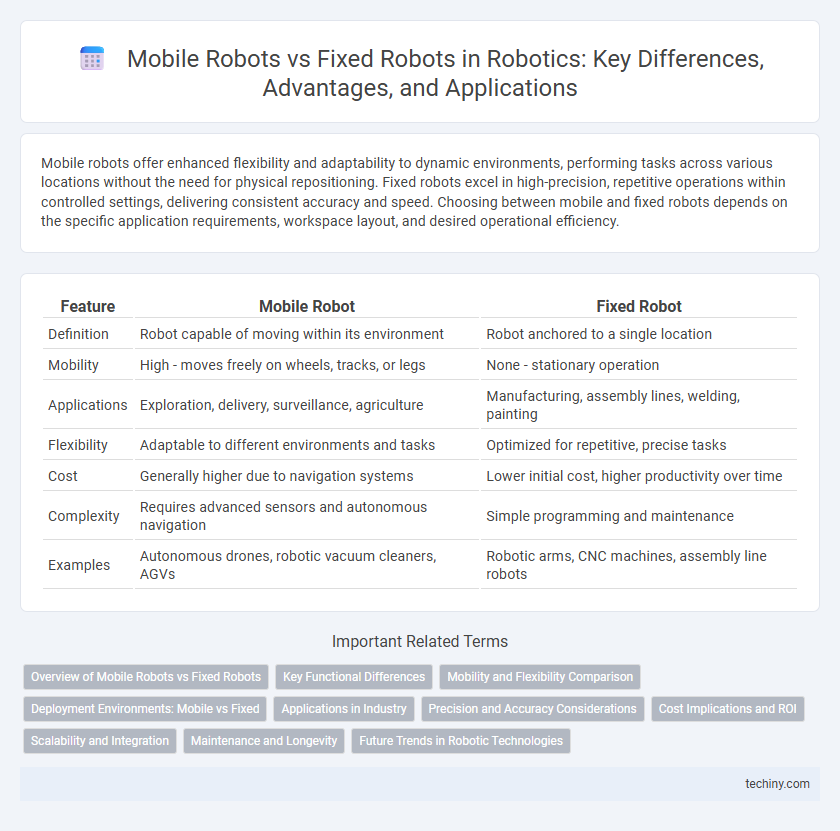Mobile robots offer enhanced flexibility and adaptability to dynamic environments, performing tasks across various locations without the need for physical repositioning. Fixed robots excel in high-precision, repetitive operations within controlled settings, delivering consistent accuracy and speed. Choosing between mobile and fixed robots depends on the specific application requirements, workspace layout, and desired operational efficiency.
Table of Comparison
| Feature | Mobile Robot | Fixed Robot |
|---|---|---|
| Definition | Robot capable of moving within its environment | Robot anchored to a single location |
| Mobility | High - moves freely on wheels, tracks, or legs | None - stationary operation |
| Applications | Exploration, delivery, surveillance, agriculture | Manufacturing, assembly lines, welding, painting |
| Flexibility | Adaptable to different environments and tasks | Optimized for repetitive, precise tasks |
| Cost | Generally higher due to navigation systems | Lower initial cost, higher productivity over time |
| Complexity | Requires advanced sensors and autonomous navigation | Simple programming and maintenance |
| Examples | Autonomous drones, robotic vacuum cleaners, AGVs | Robotic arms, CNC machines, assembly line robots |
Overview of Mobile Robots vs Fixed Robots
Mobile robots offer enhanced flexibility and adaptability by autonomously navigating diverse environments, making them ideal for dynamic tasks such as warehouse automation and delivery services. Fixed robots, anchored to specific locations, excel in repetitive, high-precision operations like assembly lines and welding, delivering consistent performance and durability. The choice between mobile and fixed robots hinges on application requirements, workspace constraints, and desired operational versatility.
Key Functional Differences
Mobile robots navigate dynamic environments using advanced sensors and adaptive algorithms, enabling autonomous movement and real-time obstacle avoidance. Fixed robots operate within a designated workspace, performing repetitive tasks with high precision and speed but limited flexibility. The key functional difference lies in mobility and adaptability, with mobile robots excelling in versatility and fixed robots optimizing stability and consistency.
Mobility and Flexibility Comparison
Mobile robots offer superior mobility by navigating dynamic environments with autonomous movement capabilities, enhancing operational flexibility across varied tasks. Fixed robots, anchored in place, provide high precision and repeatability within confined spaces but lack adaptability to different locations. The enhanced mobility of mobile robots enables broader use cases, while fixed robots excel in stability and consistent performance for repetitive processes.
Deployment Environments: Mobile vs Fixed
Mobile robots excel in dynamic and unstructured environments such as warehouses, hospitals, and outdoor settings where flexibility and navigation around obstacles are crucial. Fixed robots operate efficiently in controlled, repetitive environments like manufacturing assembly lines or packaging stations where tasks remain consistent. The choice between mobile and fixed robots depends on deployment requirements, with mobile robots offering versatility and fixed robots providing stability and precision.
Applications in Industry
Mobile robots excel in industries requiring flexible navigation, such as warehouse logistics, material handling, and automated inspection, adapting to dynamic environments and complex layouts. Fixed robots dominate in high-precision manufacturing tasks like automotive assembly, welding, and painting, ensuring consistent accuracy in repetitive processes. Combining mobile and fixed robots enhances operational efficiency by integrating mobility with specialized, stationary functionalities.
Precision and Accuracy Considerations
Mobile robots offer flexibility in navigating dynamic environments but often face challenges in maintaining precision and accuracy due to factors like sensor drift and movement instability. Fixed robots, anchored in a stable position, provide superior repeatability and high-precision operations essential for tasks requiring consistent accuracy, such as assembly or machining. The trade-off between mobility and precision necessitates selecting robot types based on application-specific accuracy requirements and environmental constraints.
Cost Implications and ROI
Mobile robots typically involve higher initial costs due to advanced navigation systems and sensors but offer greater flexibility across multiple tasks and locations, potentially increasing return on investment (ROI) in dynamic environments. Fixed robots have lower upfront expenses and are highly efficient for repetitive, high-volume operations, resulting in faster ROI in stable production settings. Evaluating cost implications alongside operational needs ensures the optimal balance between investment and long-term productivity gains in robotics deployment.
Scalability and Integration
Mobile robots offer superior scalability by easily adapting to changing environments and expanding operational areas without extensive infrastructure modifications. Fixed robots provide seamless integration into established production lines with optimized precision and repeatability but face limitations when scaling beyond their designated workspace. The flexibility of mobile robots supports dynamic task allocation and system expansion, making them ideal for evolving industrial applications.
Maintenance and Longevity
Mobile robots generally require more frequent maintenance due to their complex locomotion systems, including wheels, tracks, or legs, which are subject to wear and tear. Fixed robots benefit from a stable installation environment, reducing mechanical stress and extending component lifespan, leading to greater overall longevity. Regular inspection of drive mechanisms and sensor calibration is critical for mobile robots to maintain operational efficiency and minimize downtime.
Future Trends in Robotic Technologies
Mobile robots are advancing rapidly with improvements in autonomous navigation, sensor integration, and AI-driven decision-making, enabling more versatile applications across dynamic environments. Fixed robots are evolving through enhanced precision, adaptive controls, and collaborative capabilities, optimizing their role in repetitive or high-precision industrial tasks. Future trends emphasize hybrid systems combining mobility and fixed stability, augmented reality interfaces, and increased connectivity via IoT for seamless, intelligent robotic ecosystems.
Mobile robot vs Fixed robot Infographic

 techiny.com
techiny.com